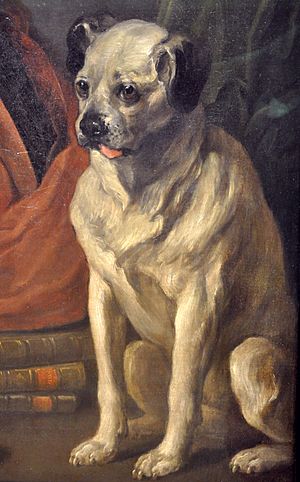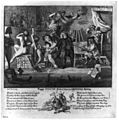Trump (dog) facts for kids

Trump (c. 1730 – c. 1745) was a pug owned by the famous English painter William Hogarth. Hogarth included his beloved dog in several of his artworks, including his 1745 self-portrait called Painter and his Pug, which is now kept at the Tate Gallery. The Tate Gallery describes Trump as a symbol of Hogarth's own strong and determined personality.
Contents
Meet Trump: Hogarth's Famous Pug
Trump's Life and Appearances in Art
Early Life and Family Portraits
William Hogarth owned many pugs throughout his life. In December 1730, he even put out an advertisement offering a reward of a half guinea (an old British coin) for the return of a lost dog named "Pugg."
Pugs often appeared in Hogarth's paintings. One of the earliest examples is his 1730 group portrait of The Wollaston Family. This painting has been on display at the New Walk Museum in Leicester since 1943.
In a scene from Hogarth's 1732–1734 series A Rake's Progress, called Married To An Old Maid, a pug seems to be getting married to a one-eyed dog. This playful scene mirrors the wedding happening in the background. There, a young man who spends too much money is marrying a wealthy older woman.
Many believe that Trump was the puppy shown in Hogarth's 1730 group portrait The Fountaine Family. This painting is at the Philadelphia Museum of Art. The adult pug in the 1738 painting The Strode Family, found at the Tate Gallery, might also be Trump. However, some sources suggest this pug belonged to one of the people in the portrait, Colonel Strode.
Sculptures and Reproductions
Around 1741, a sculptor named Louis-François Roubiliac created a sculpture of Trump. He used terracotta, which is a type of baked clay. This sculpture was made to go alongside a terracotta bust (a sculpture of the head and shoulders) of Hogarth himself.
Later in the 1740s, this reclining (lying down) terracotta figure of Trump was reproduced in Chelsea porcelain. This is a fine type of ceramic. After Hogarth passed away in 1762, plaster copies of the sculpture were sold with his belongings.
The famous potter Josiah Wedgwood also made a version of Trump in his Black Basalt ware. This is a special kind of dark pottery. He used a cast he bought in 1774. Hogarth's widow kept the original terracotta sculpture until her death in 1790. An engraving of it was made in 1799, but the original sculpture is now lost.
The Painter and His Pug Portrait
Trump was getting older when he appeared in Hogarth's 1745 painting The Painter and his Pug. In this famous self-portrait, Trump sits right next to the artist. The painting also shows an easel with Hogarth's special "line of beauty" symbol. Books by famous writers like Shakespeare, Swift, and Milton are also included.
Hogarth actually started this painting around 1735. It looked a bit different back then. Hogarth was dressed more formally and wore a wig, and Trump was not yet in the picture. The finished painting has many clever visual jokes. The dog represents Hogarth's own strong personality and his loyalty to his art. It also shows how Hogarth's portrait is supported by great English literature.
Trump in Other Famous Paintings
In 1746, Hogarth included Trump in his portrait of Captain Lord George Graham in his Cabin. This painting is at the National Maritime Museum. In this artwork, Trump is seen alongside Captain Graham's own dog. That dog is sitting at the captain's feet and seems to be joining in the singing.
Trump himself is sitting on a chair, wearing Captain Graham's wig! He looks like he's reading from a sheet of music resting against a glass.
Trump as a Symbol and Legacy
Some people jokingly called Hogarth the "Painter Pugg" because he loved his dog so much. Hogarth even used Trump as his special symbol in a funny drawing from 1763 called The Bruiser. This drawing was based on his 1745 self-portrait with Trump.
In The Bruiser, Hogarth's own portrait is replaced by a drawing of a writer named Charles Churchill. Churchill is shown as a grumpy bear. The dog in the picture is shown in a way that makes a playful jab at a book Churchill wrote that criticized Hogarth. (A copy of The Bruiser is at the National Gallery of Art in the United States.)
Because Hogarth identified so strongly with his dog, another artist named Paul Sandby drew Hogarth as a pug in his 1753 drawing Puggs Graces.
In 2001, a statue of William Hogarth with Trump was unveiled. This statue, created by Jim Mathieson, stands on the Chiswick High Road. It is very close to Hogarth's House, where the artist lived from 1749 until he passed away in 1764.
Trump in Art Gallery
Here are some of the artworks featuring Trump and other pugs by William Hogarth:
-
Painter and his Pug, William Hogarth, 1745, Tate Britain
-
The Strode Family, 1738, Tate Britain
-
Captain Lord George Graham in his Cabin, 1746, National Maritime Museum
-
The black servant on the right of Lord George Graham painting plays a pipe and tabor. Below, Hogarth's pug dog Trump balances on a chair while wearing Graham's wig
-
The Bruiser, 1763, National Gallery of Art
-
Paul Sandby, Puggs Graces, 1753
See Also









